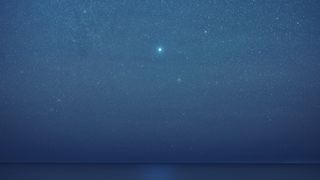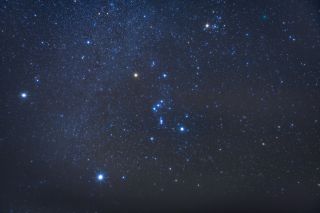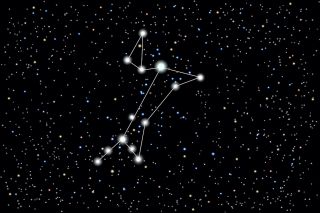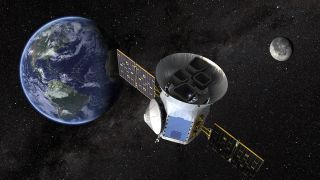Sirius: The brightest star in Earth's night sky
Sirius has been the shiniest star in the sky for a long, long time.

Sirius, also known as the Dog Star or Sirius A, is the brightest star in Earth's night sky.
The name means "glowing" in Greek — a fitting description, as only a few planets, the full moon and the International Space Station outshine this star.
Because Sirius is so bright, it was well-known to the ancients. However the discovery of a companion star, Sirius B, in 1862 surprised astronomers. The star that you can see with the naked eye is called Sirius A, or sometimes just Sirius.
Sirius B is 10,000 times dimmer than Sirius, according to NASA. It's so dim, and therefore so difficult to see from Earth, that astronomers couldn't estimate its mass until 2005, thanks to data from the Hubble Space Telescope.
How to find Sirius
Sirius is highly visible in the Northern Hemisphere's winter night sky, because the star has a high luminosity, or intrinsic brightness, relative to other stars, and because it's relatively close to Earth (8.6 light-years away). According to NASA, Sirius has a mass that's two times that of Earth's sun. If the star were placed next to our sun, Sirius would outshine it more than 20 times over, according to NASA's Astronomy Picture of the Day.
To find Sirius, use the belt of Orion as a pointer. The belt's three stars point downward toward Sirius to the left. To be more precise, the position of Sirius is:
- Right ascension: 6 hours 45 minutes 8.9 seconds
- Declination: -16 degrees 42 minutes 58 seconds

Sirius Expert Q&A

Curator and Professor, Department of Astrophysics, Division of Physical Sciences, at the American Museum of Natural History.
We asked Michael Shara, a curator in the American Museum of Natural History's Department of Astrophysics, a few frequently asked questions about Sirius.
Why is Sirius so bright?
Sirius is 25 times more luminous than our sun and just 8.6 light years distant. This combination of high intrinsic luminosity and closeness explains Sirius' brightness.
Why does Sirius appear to twinkle?
We see Sirius through our atmosphere, which is turbulent. Tiny differences in the amount of air every fraction of a second between us and Sirius cause the twinkling. Out in airless space, stars never twinkle.
Why does Sirius seem to be so colorful?
The air in our atmosphere spreads out (or "disperses") different colors of light by different amounts, creating a rainbow effect for all stars. This is most easily seen by our eyes in the case of Sirius because it's so bright.
Why is Sirius of interest to the astronomy community?
Sirius is the closest star that's more massive and a lot more luminous than our sun. Just as important, Sirius has the closest-known "white dwarf," a stellar "corpse," as a binary companion. That companion, referred to as Sirius B, has a mass equal to that of our sun, but it's 100 times smaller and thus a million times denser than our sun.
Are there any scientific mysteries surrounding Sirius that researchers would like to solve?
Historical records from the Alexandrian astronomer Claudius Ptolemy (around the year 150 AD) suggest that Sirius was a red star in the past (it is very hot and white today). There is no accepted explanation of how this could have happened.
Sirius through history
Today, Sirius is nicknamed the "Dog Star" because it is part of the constellation Canis Major, Latin for "the greater dog." The expression "dog days" refers to the period from July 3 through Aug. 11, when Sirius rises in conjunction with the sun, Space.com previously reported. The ancients felt that the combination of the sun during the day and the star at night was responsible for the extreme heat during mid-summer.
The star is present in ancient astronomical records of the Greeks, Polynesians and several other cultures. The Egyptians even went so far as to base their calendar on when Sirius was first visible in the eastern sky, shortly before sunrise. According to Joe Rao of Space.com, the Egyptians called Sirius the "Nile Star," because it always returned just before the river rose and so announced the coming of the floodwaters that would nourish their lands.

In 1718, English astronomer Edmond Halley discovered that stars have "proper motion" relative to one another, according to the Quarterly Journal of the Royal Astronomical Society. This means that stars, including Sirius, move across our sky with a predictable angular motion with respect to more distant stars.
More than 100 years after Halley's finding, in 1844, German astronomer Friedrich Wilhelm Bessel published a scientific note in the Monthly Notices of the Royal Astronomical Society describing how Sirius had been deviating from its predicted movement in the sky since 1755. Bessel hypothesized that an unseen companion star affected Sirius' motion. Alvan Graham Clark, a U.S. astronomer and telescope maker, confirmed Bessel's hypothesis in 1862 when he spotted Sirius B through Clark's newly developed great refractor telescope.
Studying Sirius
Sirius B is a white dwarf star, which is the last observable stage of a low- to medium-mass star. White dwarfs get dimmer and dimmer until they eventually stop burning and go dark, thus becoming black dwarf stars— the theoretical final stage of a star's evolution. Scientists study white dwarfs like Sirius B in hopes of gaining a better understanding of the stellar cycle. Eventually, Earth's sun will cycle to the white dwarf stage as well.

The mass of a star is an important factor in the object's stellar evolution because it determines the star's core temperature and how long and hot the star will burn. Astronomers can calculate the mass of a star based on its brightness, or luminosity, but this was challenging for Sirius B. The luminosity of Sirius A overpowered ground-based observations, making it impossible to isolate the much dimmer luminosity coming from Sirius B, according to the Astronomical Society of the Pacific.
It wasn't until 2005 when a team of astronomers assembled data collected by the Hubble Space Telescope, that scientists were able to measure the mass of Sirius B for the first time. They found that the star has a mass that is 98 percent that of Earth's sun.
To this day, Sirius continues to be a favored study subject for astronomers and physicists.
In April 2018, NASA launched the Transiting Exoplanet Survey Satellite (TESS), with the aim of its primary mission being to find exoplanets orbiting bright stars. Because Sirius is a young star, it's not likely to have planets orbiting it. TESS discovered 66 new exoplanets, according to NASA Exoplanet Exploration, but none have been discovered orbiting Sirius.
Additional resources
You can read about Hubble Space Telescope's image of Sirius A and its companion Sirius B on the European Space Agency (ESA) website. To learn more about the Canis Major and Canis Minor constellations, watch this video from Lowell Observatory.
Bibliography
"Edmond Halley– a Commemoration". Quarterly Journal of the Royal Astronomical Society, Vol. 34 (1993). https://adsabs.harvard.edu/full/1993QJRAS..34..135H
"On the variations of the proper motions of Procyon and Sirius". Monthly Notices of the Royal Astronomical Society. https://adsabs.harvard.edu/pdf/1844MNRAS...6R.136B
"On the Luminosity of the Companion of Sirius". Publications of the Astronomical Society of the Pacific. https://adsabs.harvard.edu/full/1930PASP...42..155V
"Sirius". Encyclopedia of Astronomy and Astrophysics (2001). https://ui.adsabs.harvard.edu/abs/2000eaa..bookE2394M
Join our Space Forums to keep talking space on the latest missions, night sky and more! And if you have a news tip, correction or comment, let us know at: community@space.com.
Get the Space.com Newsletter
Breaking space news, the latest updates on rocket launches, skywatching events and more!

Elizabeth Howell (she/her), Ph.D., is a staff writer in the spaceflight channel since 2022 covering diversity, education and gaming as well. She was contributing writer for Space.com for 10 years before joining full-time. Elizabeth's reporting includes multiple exclusives with the White House and Office of the Vice-President of the United States, an exclusive conversation with aspiring space tourist (and NSYNC bassist) Lance Bass, speaking several times with the International Space Station, witnessing five human spaceflight launches on two continents, flying parabolic, working inside a spacesuit, and participating in a simulated Mars mission. Her latest book, "Why Am I Taller?", is co-written with astronaut Dave Williams. Elizabeth holds a Ph.D. and M.Sc. in Space Studies from the University of North Dakota, a Bachelor of Journalism from Canada's Carleton University and a Bachelor of History from Canada's Athabasca University. Elizabeth is also a post-secondary instructor in communications and science at several institutions since 2015; her experience includes developing and teaching an astronomy course at Canada's Algonquin College (with Indigenous content as well) to more than 1,000 students since 2020. Elizabeth first got interested in space after watching the movie Apollo 13 in 1996, and still wants to be an astronaut someday. Mastodon: https://qoto.org/@howellspace